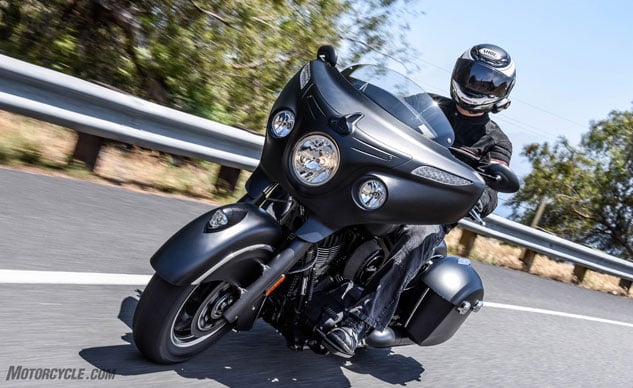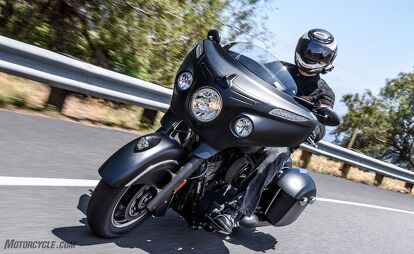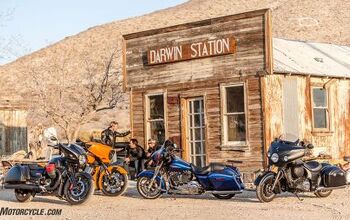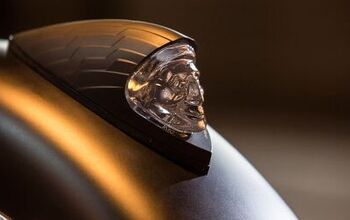2016 Indian Chieftain Dark Horse First Ride Review

Back and blacker than ever
Some may wonder why we’d bother to test a new motorcycle model that basically only includes stylistic changes from the one we tested previously. In the case of the 2016 Indian Chieftain Dark Horse, we last tested a Chieftain in November 2013 and felt enough time had passed that we needed to throw a leg over this Indian to remind ourselves what a great bike it is. Also, there was a battleship tour, in the form of the USS Iowa, involved as well as a chance to get out of the office for a ride.
2016 Indian Chieftain Dark Horse
| Engine | 17.0/20 |
| Suspension/Handling | 13.0/15 |
| Transmission/Clutch | 8.0/10 |
| Brakes | 8.25/10 |
| Instruments/Controls | 4.0/5 |
| Ergonomics/Comfort | 9.0/10 |
| Appearance/Quality | 9.25/10 |
| Desirability | 9.25/10 |
| Value | 6.25/10 |
| Overall Score | 84/100 |
The reasoning behind the development of the Chieftain Dark Horse goes back to the Chief Dark Horse, one of Indian’s most successful product launches which brought in a younger rider demographic, broadening the appeal of the Chief. Although mechanically the same as the standard Chief, the Chief Dark Horse generated a different attitude and customization path that skewed much younger. With the bagger popularity spreading beyond the typical touring-cruiser set and being embraced by younger, more urban riders, the Chieftain Dark Horse is an attempt to bottle the lightning of the Classic Dark Horse. However, this makeover wouldn’t work if the Chieftain weren’t a great bike to begin with.
The Indian’s Thunder Stroke 111 49-degree V-Twin, courtesy of the 101mm x 113mm cylinders and the single-pin crankshaft, delivers bottom-end torque and a pulse character that is sure to please cruiser fans. As we’ve noted before after running the Chieftain on the MotoGP Werks dyno, 75% of the Thunderstroke’s torque is available at just 1,000 rpm and peaks at 3,100 rpm with 102.8 lb-ft. at the rear wheel. The engine does rev slowly but never feels stressed as it grinds out the power to its 74.5-hp peak. The EFI’s fuel metering is nearly flawless, and the abrupt initial clutch engagement we previously noted is improved. Though the pipe appears unchanged, our previous quibble about the rear header baking our right inner thigh was not noticeable in the cool coastal weather of our ride. Overall, there’s a lot to like about the engine that is now dressed in fashionably black clothing.
The Chieftain’s handling is always a revelation. For a big, almost 850-lb. motorcycle, the Dark Horse feels almost nimble at speed. You do notice its heft when maneuvering in parking lots, but it is still well-balanced. The 25-degree rake steers responsively and never feels floppy, despite the fork-mounted batwing fairing. Though maneuverable, the Chieftain Dark Horse is also quite stable at speed, soaking up the bumps be they ripples in corners or expansion joints on the interstate.
One feature of the Chieftain Dark Horse’s suspension that should be noted is how the rider can use the air-adjustable rear preload to fine-tune the bike’s comfort and handling. Inside the left side-cover, a chart lists recommended air pressures for the weight that the bike is carrying. If you want a sportier ride with improved ground clearance, use the included air pump to raise the pressure above the recommended level. The compromise will be a stiffer ride. For extended freeway jaunts, drop the pressure down for a softer, boulevard ride.
When it comes to things that cruisers care about, the Chieftain Dark Horse delivers. The wind protection is good, though the shorter windshield offers a tad less with a smidge more high-frequency turbulence for a 5-ft. 11-in. rider at speeds over 80 mph. The solo saddle of the Dark Horse is quite comfortable and offers a prime location to alter the rider triangle to accommodate rider size. Dark Horse seat versions that shift the rider either one inch forward or rearward are available in the Indian accessory catalog.
Although we mentioned the keyless ignition in our previous test, we didn’t note that, if the owner happened to lose the key fob that allows this feature, the engine can still be started with a dealer-programmable/user-selectable PIN that is entered via repeatedly clicking the turnsignal switch. When the rider does have the fob, the handy saddlebag lock switch on the tank makes accessing gear super easy. This is just one of the premium features that the Dark Horse and the Chieftain share along with the 100-watt stereo with Bluetooth connectivity that can connect and control your smart phone for your entertainment needs. The dash center information panel also shows tire pressure, oil status, alternator output, and all of the stereo settings. While heated grips are an option, cruise control is standard.
Still, with the Dark Horse, the appeal of the bike above that of the standard Chieftain comes back to the updated styling. For $21,999 – $1,000 less than the Chieftain – the Dark Horse loses none of the standard features but delivers a different attitude. This shift in temperament is more than just the flat black paint that covers the bodywork. The attention to detail in which components received a black coating and which did not. The designers didn’t take the easy route and use the standard mirrors; the Dark Horse’s are black. However, just below, the brake and clutch levers wear chrome. The way the highlights contrast the darkness lead the eye to dance over the componentry. Still, Indian knows that some riders will want to take the darkness to its extreme, and black options are available for many shiny parts. Even the chrome trim on the fenders can be replaced with glossy black bits to make them stand out in a subdued way.
Does this stylistic personality adjustment work? While, at 54, I’m not directly in the bike’s youthful target market, I think the Dark Horse changes the Chieftain’s looks enough to attract attention to it. Time will tell, but I think that Indian will sell quite a few Chieftain Dark Horses. On those that are sold, I’ll wager that a ton of Indian Accessory Parts performance items will also roll out the door. Why? Because I’ve a hotted up one parked in my driveway. However, that’s a story for another day.
The 2016 Chieftain Dark Horse is in showrooms now.

Like most of the best happenings in his life, Evans stumbled into his motojournalism career. While on his way to a planned life in academia, he applied for a job at a motorcycle magazine, thinking he’d get the opportunity to write some freelance articles. Instead, he was offered a full-time job in which he discovered he could actually get paid to ride other people’s motorcycles – and he’s never looked back. Over the 25 years he’s been in the motorcycle industry, Evans has written two books, 101 Sportbike Performance Projects and How to Modify Your Metric Cruiser, and has ridden just about every production motorcycle manufactured. Evans has a deep love of motorcycles and believes they are a force for good in the world.
More by Evans Brasfield





















































Comments
Join the conversation
The engine looks great. Black makes the ridiculously large front fender look slightly less ridiculous too.
The hotted up one in your driveway...Did you get the cams, air filter and exhaust package? Would definitely like to read about that one.